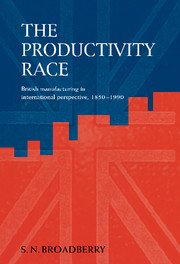Book contents
- Frontmatter
- Contents
- List of figures
- List of tables
- Acknowledgements
- Glossary of terms and company names
- 1 Introduction and overview
- Part 1 measuring comparative productivity performance
- 2 International comparisons of productivity in manufacturing: benchmark estimates by industry
- 3 Labour productivity in aggregate manufacturing: Britain, the United States and Germany
- 4 Extending the picture: manufacturing productivity in other industrialised countries
- 5 Manufacturing and the whole economy
- Part 2 explaining compartive productivity performence
- Part 3 reassessing the performance of British industry
- Bibliography
- Index
2 - International comparisons of productivity in manufacturing: benchmark estimates by industry
Published online by Cambridge University Press: 28 October 2009
- Frontmatter
- Contents
- List of figures
- List of tables
- Acknowledgements
- Glossary of terms and company names
- 1 Introduction and overview
- Part 1 measuring comparative productivity performance
- 2 International comparisons of productivity in manufacturing: benchmark estimates by industry
- 3 Labour productivity in aggregate manufacturing: Britain, the United States and Germany
- 4 Extending the picture: manufacturing productivity in other industrialised countries
- 5 Manufacturing and the whole economy
- Part 2 explaining compartive productivity performence
- Part 3 reassessing the performance of British industry
- Bibliography
- Index
Summary
Introduction
There exist a number of studies comparing labour productivity in British manufacturing with the United States and Germany at a number of points in time since the 1930s. Some of these studies have become integrated into the economic history literature and are widely cited (Rostas, 1948a; Paige and Bombach, 1959). In this chapter, these existing estimates are gathered together on a common basis and extended with a number of additional new estimates going back as far as the first British Census of Production for 1907.
As well as discussing the methodology underlying these estimates, this chapter uses the individual industry estimates to shed some light on the growth process by identifying the particular strengths and weaknesses of countries, and showing how their comparative advantages have evolved over time. Detailed data are presented for up to 77 industries in appendix tables A2.1 and A2.2 (pp.28 and 31). To help in identifying patterns, the data are also presented at an intermediate level of disaggregation. The figures for these six industry groups are gathered together in tables 2.3 and 2.4 (p.26). The chemicals, metals and engineering industries are conventionally seen as ‘heavy’, or large-scale industries, while textiles and clothing, food, drink and tobacco and other industries are seen as ‘light’ or smaller-scale industries.
The benchmark estimates
Estimation methods for individual industries
There are basically two approaches to the establishment of comparative labour productivity levels in an industry.
- Type
- Chapter
- Information
- The Productivity RaceBritish Manufacturing in International Perspective, 1850–1990, pp. 19 - 33Publisher: Cambridge University PressPrint publication year: 1997



